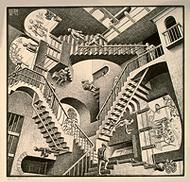 Maurits Cornelis Escher (1898-1972)
Maurits Cornelis Escher (1898-1972)
World of Escher
MCEscher.com, the ‘official’ Escher site.
Escher’s World has several Java applets of tesselations that you can change by clicking and dragging with your mouse.
World of Escher – The Site for Everything Escher “are proud to be here to tell you stories, discuss M.C. Escher’s works, provide insight, and offer our high quality products promoting the intriguing work of Escher. […] Along with discussions on Escher we have also included ideas and readings regarding Professor Roger Penrose and his mathematically based puzzles.”
The Mathematical Art of M.C. Escher, part of the Platonic Realms, has a great introduction to Escher’s works and explains tesselations, polyhedra, the shape and logic of space.
M.C. Escher Centennial Celebration Page. “M.C. Escher has fascinated young and old with his unique interpretation of the world around us in his drawings and prints. From impossible worlds to repeating pattern tessellations, Escher shows us the unique harmony and beauty that are in simple things in our surroundings. This site is a celebration of the Centennial of M.C. Escher and contains information about exhibitions, educational resources, and links to other Escher sites.”
Galleries
Escher Gallery at the National Gallery of Canada
Escher Gallery (page 1 of 8) at the National Gallery in Washington, USA.
Escher Art Collection which also includes a few works after Escher.
Kyle’s Personal Asylum. A collection of Escher’s work.
The Art of Escher, part of The Shrine of Escher.
Escher Wallpapers, a collection of desktop pictures.
Math and Teaching
Teaching Escher: Using Escher in Classrooms. “This page is a resource for those who are interested in teaching about Escher and integrating his artwork into a school curriculum. Escher’s art captivates young and old and is a fun and educational way of learning about art, mathematics, and sciences.” (Part of the Escher Centennial Celebration page, see above.)
Example: Model Unit (Grade 7): M.C.Escher: The Poet of the Impossible.. “In this unit, we see integration of two subjects (mathematics and visual arts) with the concrete (the art of M.C. Escher).”
For reading about M.C. Escher and his artwork, I recommend Bruno Ernst: Magic Mirror of M.C. Escher, ISBN: 1886155003. (Oder auf deutsch: Bruno Ernst: Der Zaberspiegel des Maurits Cornelis Escher. ISBN 3822889474.)
Interactive
Escher Web Sketch is a Java applet that allows you to draw repeating patterns. You can select the symmetry of the patterns, the drawing tool and colour and the pattern size.
Oliver created a QuickTime VR of one of Escher’s graphics. It is here. And for comparison, take a look at Escher’s grahpic here.
An interactive site on the life and works of M.C. Escher. (Requires Flash.)
Animated Escher drawing
Hendrik Lenstra calculated (New York Times link) what belongs in the blank space of a drawing by M. C. Escher and created an animation of his version of the drawing.
Escher in Lego
Andrew Lipson and Daniel Shiu recreated some of Escher’s artwork in Lego: Balcony, Belvedere, Ascending and Descending, Relativity and Waterfall.
Thanks for some of the links to Ernst, Jörg, Jan-Willem and Becky! ![]()
Collected from 2001/01/24, 2001/02/06, 2001/03/05, 2001/06/19, 2002/05/30, and 2003/07/08.
